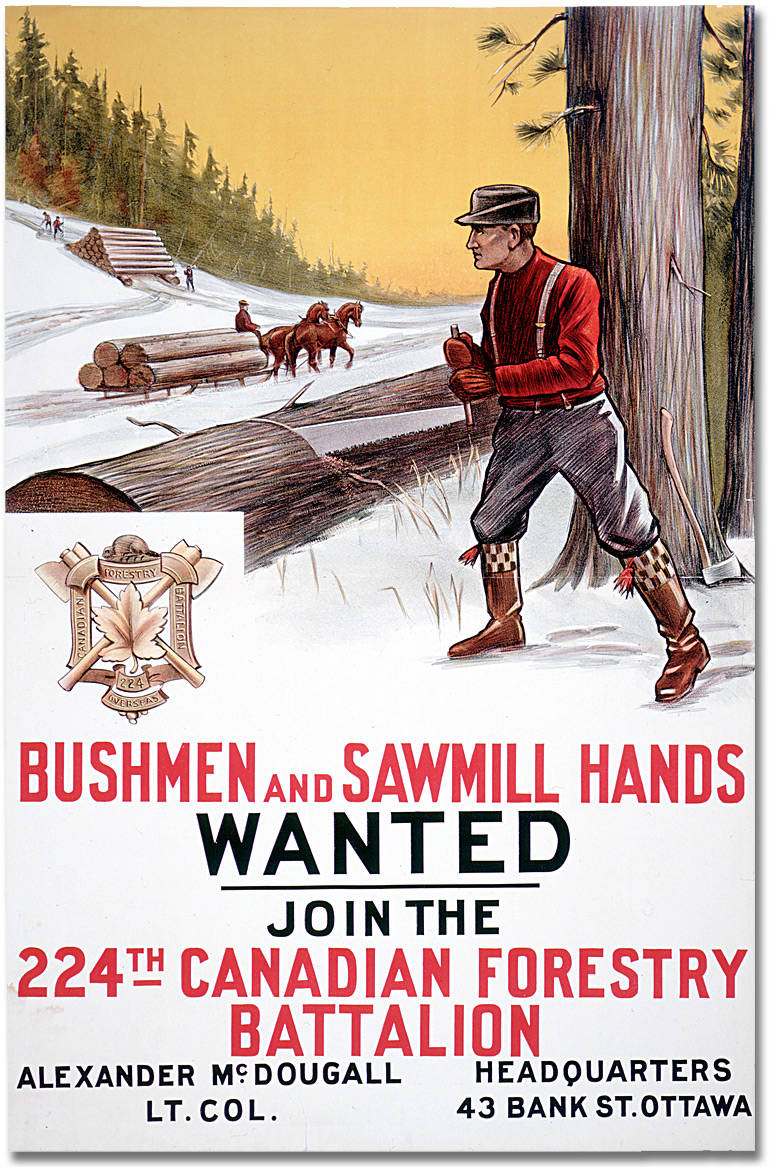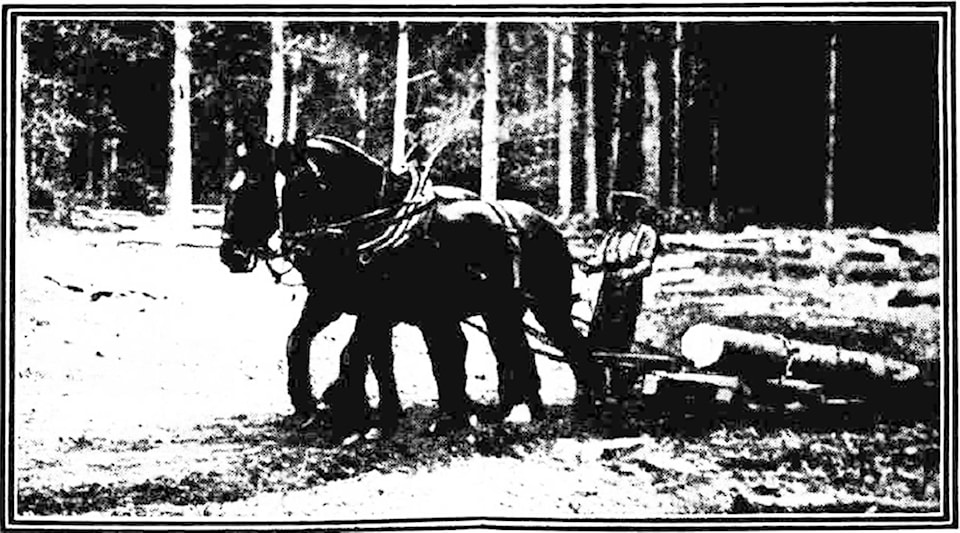Sherlock Inghram was two months shy of his 18th birthday when he pledged his service to King George V and enlist as a member of the Canadian Expeditionary Force in the First World War. The 17-year-old from Rock Creek signed up to join with his father, Barton (Bart), in the Canadian Forestry Corps on May 11, 1917. On his own registration documents signed the same day, Bart indicated that his son was already 18.
So, soon after completing his medical evaluation — five-foot nine-inches, 145 pounds, fair skin, blue eyes like his father and “distinguishing marks or scars: nil” — the underage private boarded a boat in Halifax and stepped onto a Liverpool dock on July 4, one day after he turned 18.
The Inghrams were two among thousands of much-needed Canadians who served in the forests of Europe in the First World War. By 1916, Great Britain was quickly burning through its timber supply and sourcing 70 per cent of its lumber from Canada was becoming increasingly unsustainable. Cargo space was nonexistent onboard transport vessels that were busy dodging German U-boat attacks on the trans-Atlantic journey.
In February 1916, Great Britain demanded help from Canada — two months later, 1,600 cross-cut-saw-wielding Canadian lumberjacks were sailing to Europe to cut trees in Scotland, Wales, England and France. By Armistice Day in 1918, nearly 24,000 men made up the Canadian Forestry Corps.
What it takes
to build a war
With trenches and tunnels drenched and rotting in the French rain, the demand for lumber seemed as perpetual as the war itself, said Maj. Michael Boire, a historian at the Royal Military College of Canada. “You just don’t build something once on the Western Front, you rebuild it every other week.”
Sherlock Inghram would be late to feed the saw’s teeth, though. Ten days after arriving in England, he was admitted to hospital for measles; rubella would follow in August and plague him until he was finally released on Sept. 10, 1917. One month later, he finally joined his father in France and began felling and milling trees.
In the fall of 1917, when they were working at a camp in France, Sherlock Inghram wrote home to say that he was “swinging an axe ten hours a day, within a mile of the first firing line,” while airplanes buzzed overhead. Chopping trees with steel helmets made for tough work, Inghram added. In the same dispatch, Bart noted, perhaps tongue-in-cheek, that the Kootenay–Boundary men were “having fine weather, as it had not rained or snowed for half an hour.”
Eventually, though, there came a moment when some lumberjacks were asked to swap their axes for rifles. When the call came from command in March 1918 for 500 additional Canadian soldiers to join the front line, 1,300 Forestry Corps men volunteered – the Inghram men’s records indicate that they continued to serve in the forestry corps. Meanwhile at home, Prime Minister Robert Borden struggled to muster the same enthusiasm and had resorted to a severely unpopular conscription law to fulfill his promises to Great Britain.
“Sure, the volunteering was oversubscribed [compared to that in Canada],” Boire said of the overwhelming response amid the Forestry Corps. “But that’s a typical reaction of the boys up front. They had to go home someday to answer the question, ‘What did you do in the war, Daddy?’” Volunteers compelled by notions of duty and honour spurred the surge in enlistments.
Working deep in forests and often away from the front lines, the lumberjacks were not necessarily considered brave soldiers, Boire said. But by 1918, many had resolved to prove their compatriots living and dying in trenches wrong.
Still, some saw the Forestry Corps as a means of avoiding battle. In a letter to his mother, front-line soldier John Row wrote of his uncle in the Forestry Corps: “He is a wise guy alright [sic] but it would look better if he took a spell at the front. There are too many of these heroes who stay in England.”
But life in the bush was by no means a luxury, as a dispatch from Bart can attest.
“One Sunday,” a story in The Ledge begins, “Bart and young Arnold of Nelson walked seven miles to a village, where they got six eggs, coffee and black bread […]. It was the first time since leaving Nelson that they had tasted eggs or coffee.”
In Canada, some politicians nevertheless doubted the usefulness of the Corps.
“It is felt the Forestry Corps staff is a refuge for personal friends of those in higher command,” argued opposition MP Rodolphe Lemieux in a parliamentary committee in April 1918. Some newspapers in Great Britain agreed. “A tremendous number of administration problems have to be worked out — from the handling of a special hospital service for the Corps to the proper handling of the discipline for the men, who are not trained soldiers, and a thousand other questions,” reads the Dec. 28, 1917, issue of The Scotsman.
Yet despite negative reviews, the Canadian Forestry Corps kept chopping, cutting, milling and sawing relentlessly. In one day at a single La Joux mill in France, workers produced enough lumber to build 11 modern-day three-bedroom homes. Young Sherlock Inghram’s own discharge documents tell a similar story. He gained 13 pounds while chopping wood in France.
The Corps’ productivity was praised by government and media alike. The same critical article from The Scotsman wrote that “[The Corps’] monthly output, if it could be published, would read like fiction,” echoing the words of the British Secretary of State for the Royal Air Force, who suggested that 170 Canadians could easily do the work of 600 Britons.
The First World War ended 101 years ago, in November 1918, and the mills in France, England and Scotland lurched to a halt. Sherlock Inghram returned to the southern Interior, his discharge medical document still reading “distinguishing marks or scars: nil,” and took up work at a mill in Nakusp, again alongside his father.
In France, trees regrew and forests renewed, and though saws and gears rusted in the camps, they would be raided again 20 years later by the return of war and with it, the Canadian Forestry Corps. Sherlock would not make it back across the Atlantic. He died in Trail on Jan. 1, 1921.
— With files from
Al Donnelly

